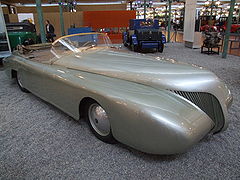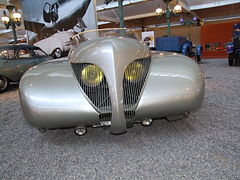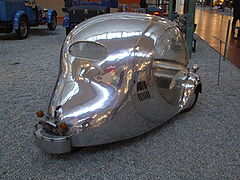
Paul Arzens
Encyclopedia




France
The French Republic , The French Republic , The French Republic , (commonly known as France , is a unitary semi-presidential republic in Western Europe with several overseas territories and islands located on other continents and in the Indian, Pacific, and Atlantic oceans. Metropolitan France...
industrial designer of railway locomotive
Locomotive
A locomotive is a railway vehicle that provides the motive power for a train. The word originates from the Latin loco – "from a place", ablative of locus, "place" + Medieval Latin motivus, "causing motion", and is a shortened form of the term locomotive engine, first used in the early 19th...
s and motor cars.
Arzens was born in Paris, at an address along the Boulevard des Batignolles on the northern side of the city. As a young man he studied at the École des Beaux-Arts
École Nationale Supérieure des Beaux-Arts
The École Nationale Supérieure des Beaux-arts is the distinguished National School of Fine Arts in Paris, France.The École des Beaux-arts is made up of a vast complex of buildings located at 14 rue Bonaparte, between the quai Malaquais and the rue Bonaparte, in the heart of Saint-Germain-des-Près,...
and soon gained recognition as a talented artist able at this stage, unusually, to live reasonably well on the sales proceeds from his paintings. This gave him enough time to pursue other interests in the realms of engineering and design. As his life progressed he accumulated a large collection of his own paintings and gained a reputation for an acute reluctance to sell any.
Cars
In 1935 Arzens turned his interests to automobile engineering. He designed and constructed a six-speed automatic transmission which he installed in an old Chrysler and which worked. Robert Peugeot tried the car and was impressed, although hopes that the system might be adopted for the Peugeot 402Peugeot 402
The Peugeot 402 is a family car produced in Sochaux, France from 1935 to 1942 by Peugeot. It was unveiled in Paris Motor Show in 1935, replacing the Peugeot 401....
came to nothing, possibly because Peugeot had recently signed a deal with Cotal
Preselector gearbox
A preselector or self-changing gearbox is a type of manual gearbox used on a variety of vehicles, most commonly in the 1930s...
involving their pre-selector transmission.
Two years later Arzens came up with an eye-catching and streamlined two seater cabriolet prototype body built around the chassis of an old Buick
Buick
Buick is a premium brand of General Motors . Buick models are sold in the United States, Canada, Mexico, China, Taiwan, and Israel, with China being its largest market. Buick holds the distinction as the oldest active American make...
. The car was christened "La Baleine" (the whale). With its integrated headlights, panoramic curved windscreen (of "plexiglas") and proto-ponton format styling the design anticipated sports cars of the 1950s and 1960s. The car subsequently joined the Bugatti
Bugatti
Automobiles E. Bugatti was a French car manufacturer founded in 1909 in Molsheim, Alsace, as a manufacturer of high-performance automobiles by Italian-born Ettore Bugatti....
s of the Sclumpf Collection at what has become the National Motor Museum in Mulhouse
Mulhouse
Mulhouse |mill]] hamlet) is a city and commune in eastern France, close to the Swiss and German borders. With a population of 110,514 and 278,206 inhabitants in the metropolitan area in 2006, it is the largest city in the Haut-Rhin département, and the second largest in the Alsace region after...
.
Two years later, following the German invasion, and the virtual disappearance of petrol for civilian use, Arzens came up with a second Baleine, closely resembling the first at least from the outside, but based on the chassis of an old Fiat - much lighter than a Buick - and encumbered by 1,100 Kg of accumulator batteries. This was an elecric vehicle with a claimed 10 hp providing a range of more than 200 km (125 miles) at 65/70 km/h (approx 40 mph).
Arzens' next automotive one-off appeared in 1942 and was instantly christened "L'Oeff" (the eff), reflecting it egg-shape. Other eye catching featured were the tiny wheels and the high proportion of the bodywork formed of curved transparent plexiglas. The body itself weighed just 60 Kg, although adding he electric rear mounted a motor raised this to 90 Kg. Once batteries were added the vehicle weight was increased to 350 Kg, allowing for a range of 100 km (63 miles) at 70 km/h (44 mph) or at 60 km/h 37 mph if two people were on board.
Rail locomotives
In 1947 Paul Arzens was placed on the payroll of the French National Railway Company (SNCF)SNCF
The SNCF , is France's national state-owned railway company. SNCF operates the country's national rail services, including the TGV, France's high-speed rail network...
and his first commission for them dates from that same year. Arzens was behind the designs of the BB and CC locomotives and their numerous derivatives which would together dominate the French railway network during the 1950s, 1960s and 1970s.
One of his earlier designs was for the smooth fronted CC7700 series. It was one of these, the CC7707, which broke the electric train speed record in 1955. The record would stand until broken by a TGV
TGV
The TGV is France's high-speed rail service, currently operated by SNCF Voyages, the long-distance rail branch of SNCF, the French national rail operator....
in 1981. Ahrens was also behind the reverse sloping front window characteristic of locomotives such as the BB15000
SNCF Class BB 15000
The SNCF class BB 15000 is a class of 25kV 50Hz electric locomotives built by Alsthom and MTE between 1971 and 1978. Initially 65 locomotives strong, the series was widely used on the whole French 25kV network before losing services to TGV trains when the LGV Est went into service in...
, which he said had been inspired by the form of a "sprinter on the starting block".

